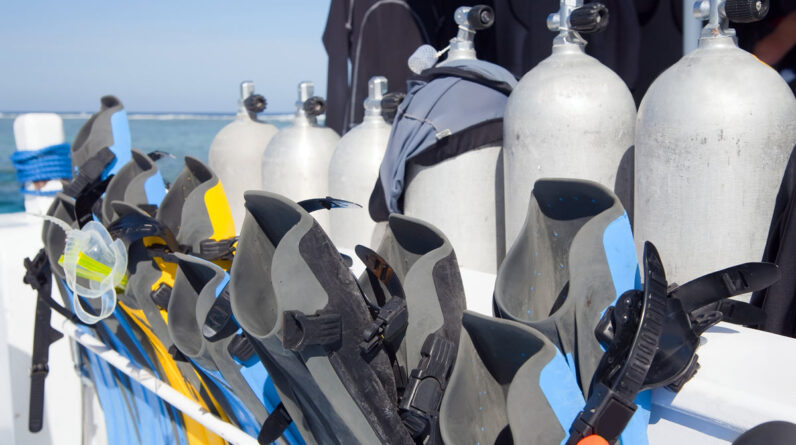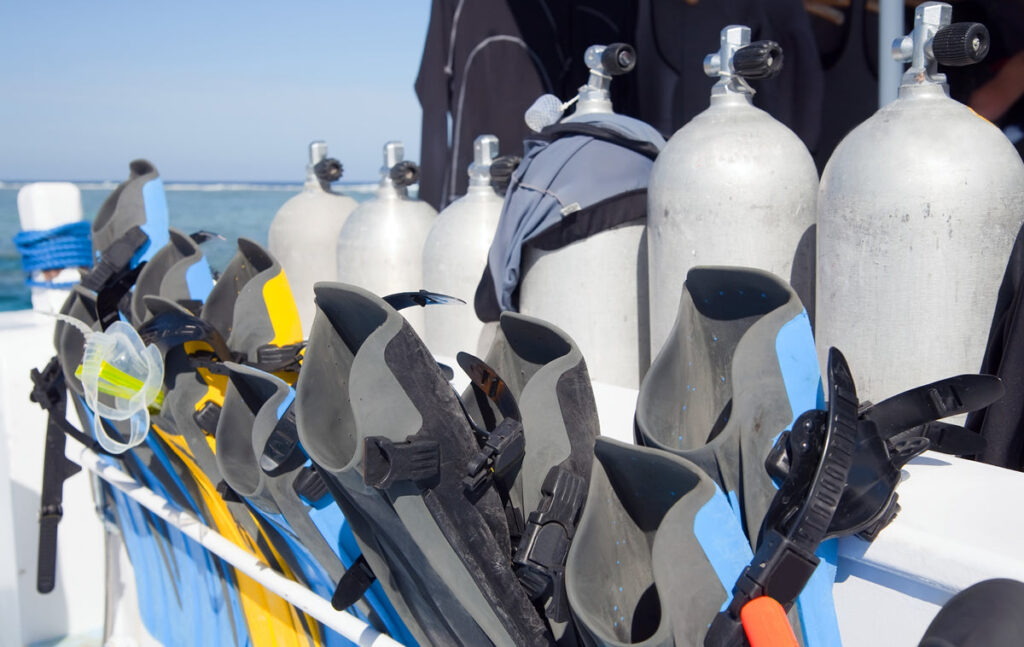
When it comes to keeping your scuba diving fins in the best condition, proper care and storage are key. Taking care of these essential pieces of equipment not only extends their lifespan, but also ensures optimal performance while exploring underwater. In this article, discover simple yet effective tips on how to care for and store your scuba diving fins, allowing you to focus on the thrilling adventures that await beneath the waves.

This image is property of www.tdisdi.com.
Cleaning Your Scuba Diving Fins
Cleaning the Blades
To maintain the performance and longevity of your scuba diving fins, it’s crucial to regularly clean them. Start by rinsing off any sand, debris, or saltwater residue from the blades. You can use fresh water and a gentle scrub brush or sponge to remove any stubborn dirt. Be sure to pay attention to the edges and crevices of the blades to ensure a thorough cleaning.
Cleaning the Foot Pockets
While cleaning the blades is essential, don’t forget to give some attention to the foot pockets. Rinse them well with fresh water, ensuring that any sand or dirt is washed away. If there are any remnants of saltwater or debris, use a soft cloth or brush to gently remove them. Pay close attention to the area where your foot rests, as this is where dirt and grime tend to accumulate.
Drying the Fins
After cleaning your scuba diving fins, it’s important to allow them to dry thoroughly to prevent the growth of mold or mildew. Start by removing any excess water by shaking the fins gently or wiping them with a towel. Then, allow them to air dry in a well-ventilated area away from direct sunlight. Avoid placing them on a radiator or using a hairdryer, as excessive heat can damage the fin material.
Removing Saltwater Residue
Saltwater residue can be corrosive and cause damage to your scuba diving fins if not properly removed. To remove salt deposits, you can soak the fins in a mixture of fresh water and mild dish soap for approximately 15-20 minutes. After soaking, rinse the fins thoroughly with fresh water to ensure all the soap and saltwater residue is removed. This step is especially crucial if you have been diving in saltwater environments.
Maintaining Your Scuba Diving Fins
Inspecting for Damage
Regularly inspecting your scuba diving fins is vital to catch any damage early on. Look for any cracks, tears, or loose parts in the blades, foot pockets, straps, and buckles. If you notice any damage, it’s essential to address it promptly to prevent further deterioration.
Repairing Minor Damage
If you come across minor damage on your scuba diving fins, there are several temporary fixes you can try. Small tears or cracks in the blades can be repaired using waterproof adhesive or patch kits specifically designed for scuba gear. Follow the instructions provided with the adhesive or patch kit carefully to ensure a proper and secure repair.
Replacing Straps and Buckles
Over time, the straps and buckles on your scuba diving fins may become worn, loose, or damaged. It’s crucial to replace them as soon as you notice any signs of wear to prevent any accidents or discomfort during your dives. Most scuba diving shops or online retailers offer replacement straps and buckles that are compatible with various fin models.
Maintaining the Buckles and Straps
To keep the buckles and straps in good condition, it’s important to clean and lubricate them regularly. Use fresh water and a soft cloth to remove any dirt or debris from the buckles and straps. After cleaning, apply a silicone-based lubricant to ensure smooth operation and prevent corrosion. Avoid using petroleum-based products as they can degrade rubber and other fin materials.
Proper Storage for Scuba Diving Fins
Rinsing the Fins
Before storing your scuba diving fins, it’s essential to rinse them thoroughly with fresh water. This step will remove any remaining saltwater or debris that could cause damage or foul odors if left on the fins for an extended period. Ensure that both the blades and foot pockets are rinsed properly.
Drying the Fins
After rinsing, allow your scuba diving fins to dry completely before storing them. Use a towel or shake off any excess water, and then let the fins air dry in a well-ventilated area. It’s crucial to ensure that no moisture is trapped inside the foot pockets or between the blades, as this can lead to mold or mildew growth.
Storing in a Dry Area
When it comes to storing your scuba diving fins, choose a dry area away from direct sunlight or extreme temperatures. Exposure to sunlight can cause the fin material to degrade, while high temperatures can warp or distort the fins. A dedicated gear bag or storage container is an excellent option to keep your fins protected and organized.
Avoiding Direct Sunlight
Direct sunlight can be harmful to your scuba diving fins, causing the materials to deteriorate over time. When storing your fins, avoid leaving them exposed to sunlight for extended periods. If possible, store them in a shady area or use a gear bag that provides UV protection. Keeping your fins shielded from sunlight will help maintain their quality and prolong their lifespan.
Avoiding Common Mistakes
Walking in Dive Fins
It’s important to remember that scuba diving fins are designed for swimming, not walking. Walking in dive fins can put unnecessary strain on the blades, foot pockets, and straps, leading to damage or even injuries. Always remove your fins or use protective fin booties when walking on land to avoid any accidents or unnecessary wear and tear.
Using Fins for Non-Diving Activities
While it might be tempting to use your scuba diving fins for other water activities, such as snorkeling or bodyboarding, it’s best to use fins specifically designed for those activities. Scuba diving fins are generally sturdier and heavier, and may not provide optimal performance or comfort during other water sports. It’s always best to use the appropriate gear for each activity to ensure safety and enjoyment.
Not Properly Rinsing the Fins
Failing to rinse your scuba diving fins thoroughly after each dive can lead to the accumulation of salt, sand, and debris. Over time, these substances can degrade the fin material and affect their performance. Make it a habit to rinse your fins with fresh water after every dive to remove any potentially harmful residue.
Using Harsh Cleaners
When cleaning your scuba diving fins, it’s crucial to avoid using harsh cleaners or solvents. These can damage the fin material and compromise their integrity. Stick to mild dish soap or specifically formulated cleaners for scuba gear. Always follow the manufacturer’s instructions and avoid using abrasive materials that can scratch or damage the fins.

This image is property of www.tdisdi.com.
Transporting Scuba Diving Fins
Choosing the Right Gear Bag
Transporting your scuba diving fins safely starts with choosing the right gear bag. Look for a bag specifically designed for scuba gear that provides adequate protection and organization. Consider features such as reinforced handles, padding, and separate compartments to ensure your fins are securely stored during transportation.
Protecting the Fins
To prevent any damage during transportation, it’s essential to protect your scuba diving fins from impact and rough handling. You can use fin protectors, which are specially designed covers that fit over the blades, to provide an extra layer of protection. Alternatively, wrapping the fins in a towel or using bubble wrap can also help cushion them against any potential bumps or jolts.
Securing in the Bag
When packing your scuba diving fins in your gear bag, make sure they are securely fastened or strapped down to prevent them from shifting during transit. This will help avoid any unnecessary stress on the fins and minimize the risk of damage. Some gear bags come with adjustable straps or compartments specifically designed for securing fins, making it easier to keep them in place.
Avoiding Heavy Loads
When transporting your scuba diving fins, it’s important to avoid overloading your gear bag or placing heavy objects on top of the fins. Excessive weight can put pressure on the fins, causing them to bend, warp, or break. Always pack your gear bag thoughtfully, distributing the weight evenly to ensure the safety and integrity of your fins.
Emergency Repairs
Temporary Fixes
In case of minor damage or accidents during a dive trip, it’s helpful to have some temporary fixes on hand. Waterproof adhesive or patch kits can come in handy for patching small tears or cracks in your scuba diving fins. These quick fixes can save your dive trip and provide temporary solutions until you can seek professional repair.
Using Adhesive and Patch Kits
When using adhesive or patch kits for emergency repairs, make sure to read and follow the instructions carefully. Clean the damaged area thoroughly, apply the adhesive or patch according to the manufacturer’s guidelines, and allow sufficient drying or curing time before using the fins again. While these fixes might not be as durable as professional repairs, they can serve as temporary solutions to keep you diving.
Contacting a Professional
For more severe or complex damage to your scuba diving fins, it’s best to seek professional repair services. Contact your local dive shop or a trusted professional who specializes in scuba gear repairs. They will have the expertise and proper tools to assess and fix the damage effectively, ensuring your fins are safe and ready for future dives.

This image is property of www.scubadoctor.com.au.
Tips for Prolonging the Lifespan
Avoiding Dragging or Dropping Fins
To prolong the lifespan of your scuba diving fins, it’s essential to handle them with care. Avoid dragging or dropping your fins, as this can cause scratches, cracks, or other forms of damage. When entering or exiting the water, be mindful of your surroundings and always handle your fins gently.
Using Fin Protectors
Investing in fin protectors is a great way to safeguard your scuba diving fins from unnecessary wear and tear. These protective covers fit snugly over the blades and provide an additional layer of protection against scratches, impacts, and UV radiation. By using fin protectors, you can significantly prolong the lifespan of your fins and keep them in optimal condition.
Replacing Rubber Straps Regularly
Rubber straps on scuba diving fins can become worn or damaged over time. It’s important to replace them regularly to ensure a secure and comfortable fit. Check the condition of the straps frequently and replace them if you notice any signs of wear, stretching, or deterioration. Properly fitted and functional straps will enhance your diving experience and prolong the life of your fins.
Storing Fins Away from Sharp Objects
When storing your scuba diving fins, make sure to keep them away from any sharp or abrasive objects. Store them in a dedicated gear bag or container where they won’t come into contact with other equipment or potential hazards. This will protect the fins from scratches, cuts, or other forms of damage and help maintain their overall quality.
Choosing the Right Scuba Diving Fins
Considering Fin Type
When selecting scuba diving fins, it’s important to consider the type of diving you will be doing. Different fin types, such as split fins, paddle fins, or jet fins, offer varying levels of performance and maneuverability. Research the characteristics of each fin type and choose the one that best suits your diving style and needs.
Evaluating Foot Pocket Design
The foot pocket is a crucial component of scuba diving fins, as it directly affects comfort and fit. Look for fins with ergonomic foot pocket designs that provide a snug and secure fit without causing discomfort. Consider the size, shape, and material of the foot pockets and choose the ones that align with your foot shape and size.
Assessing Blade Material
The material of the fins’ blades plays a significant role in their performance and durability. Common materials used for fin blades include plastic, fiberglass, and carbon fiber. Each material has its own advantages and characteristics, such as flexibility, responsiveness, and resistance to wear. Evaluate your diving needs and preferences, and choose the blade material that aligns with them.
Selecting the Appropriate Size
Selecting the right size of scuba diving fins is crucial for comfort, performance, and safety. Fins that are too loose or too tight can cause discomfort or hinder your ability to kick efficiently underwater. Consult the manufacturer’s size chart and consider trying on different sizes to find the one that provides a snug fit without squeezing or rubbing.

This image is property of rushkult.com.
Frequently Asked Questions
How often should I clean my scuba diving fins?
It’s recommended to clean your scuba diving fins thoroughly after each dive to remove any saltwater, sand, or debris. Regular cleaning will help prevent the accumulation of harmful substances and maintain the performance and lifespan of your fins.
Can I use my fins in chlorinated swimming pools?
While scuba diving fins can technically be used in chlorinated swimming pools, it’s generally not recommended. Chlorine can degrade the fin material over time, causing them to become brittle or lose their optimal performance. It’s best to use fins specifically designed for pool or recreational swimming in such environments.
What can I do to prevent foot pocket discomfort?
To prevent foot pocket discomfort, ensure that you choose scuba diving fins with the right size and foot pocket design for your feet. Wearing fin socks or booties can also provide extra cushioning and minimize friction between your feet and the foot pockets.
Should I lubricate the buckles and straps?
Yes, it’s a good practice to lubricate the buckles and straps of your scuba diving fins regularly. Use a silicone-based lubricant to ensure smooth operation and prevent corrosion. Lubrication will prolong the lifespan of the buckles and straps and enhance your overall diving experience.
Conclusion
Properly caring for and storing your scuba diving fins is essential to ensure their longevity, performance, and your safety during dives. Regularly cleaning, inspecting, and maintaining your fins will help prevent damage and enhance their lifespan. Additionally, choosing the right gear bag, storing the fins properly, and avoiding common mistakes will contribute to their longevity. By following these guidelines, you can enjoy many memorable diving adventures with your well-maintained scuba diving fins.

This image is property of cdn.shopify.com.






